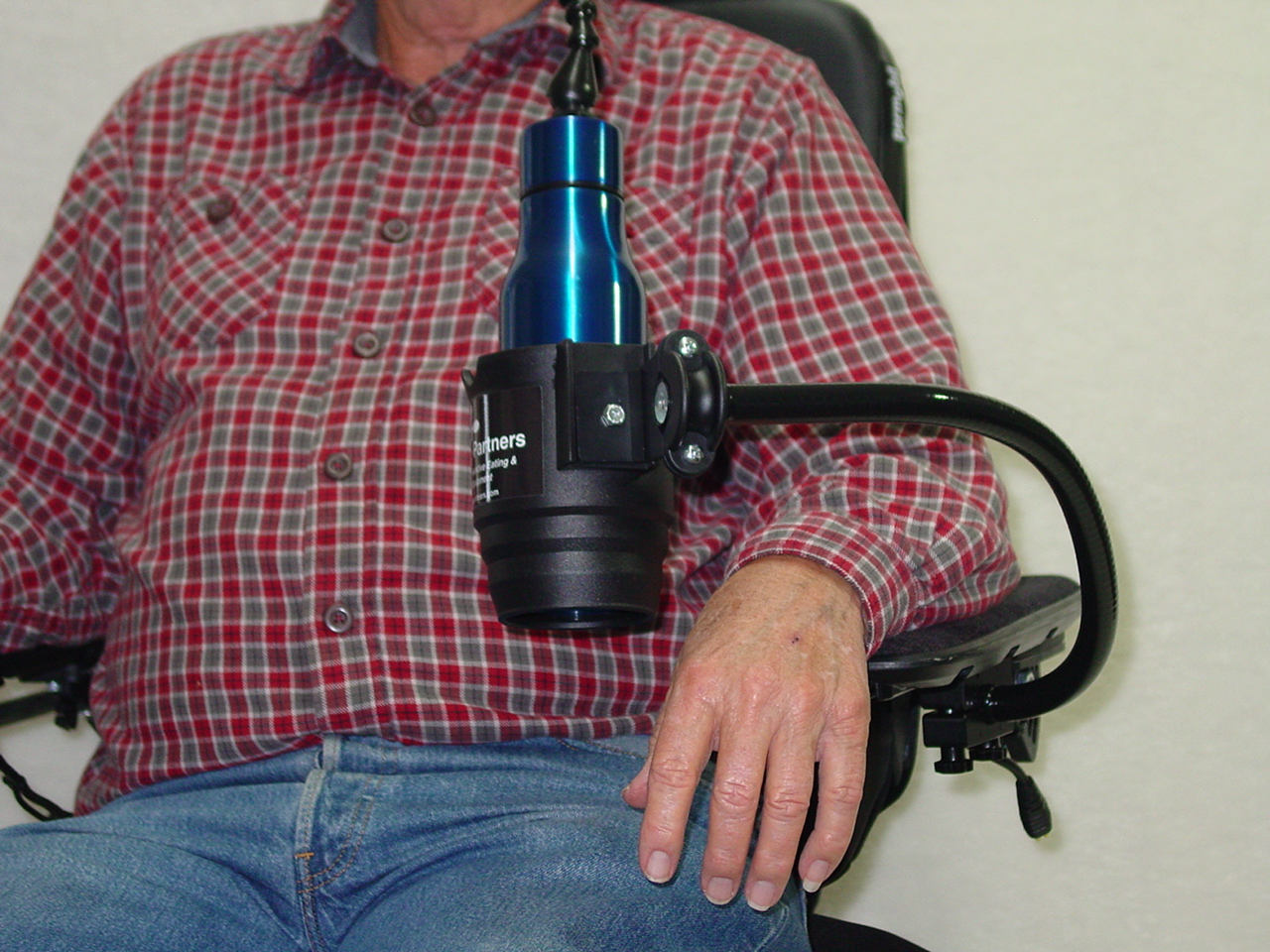Mealtime Partners, Inc.
Specializing in Assistive Dining and Drinking Equipment
February 2017 Independent Eating and Drinking Newsletter

|
February Topics:
|
||
|
Mealtime Partners Home Page Send a Comment or Suggestion |
|||
| Subscribe to Newsletters |
Neurogastronomy is a relatively new scientific field; it is the combined study of culinary science and the study of how our brain perceives flavor and how that impacts our experience with eating and drinking. This area of study is important because it can potentially influence how problems with eating can be alleviated. For example, individuals who are being treated for cancer often find that their sense of taste changes and food no longer tastes good. Food often has a metallic taste which is unpleasant. These people need to continue to eat well to support their recovery; however, frequently their food intake declines and they develop secondary problems due to undernutrition. Understanding how the brain interprets flavors can potentially allow chefs to create food that is appealing, despite the changes in the brains interpretation of how food tastes.
In 2006, Gordon Shepherd, MD, D Phil., professor of neuroscience at the Yale School of Medicine, first used the term "neurogastronomy" in an article published in the journal Nature to describe a discipline of the biochemistry of food preparation, the molecular biology of the olfactory receptors, and the knowledge of odor images and the brain flavor system.
He described the olfactory system and it’s processing of odors as being similar in function to that of the eye and vision.
When we eat, taste buds on our tongue send signals to the brain that are converted into what we perceive as taste. They sense sweet, salty, sour, bitter, and umami. Yet that is just the tip of the iceberg! Before food enters our mouth we see it and smell it, and our brain is already processing that information before we actually have put the food in our mouth. An example of this is when you walk past a bakery and see and smell chocolate cake or bread being baked. Your eyes perceive something that will taste good. Your nose smells something that will taste good and these things trigger our mouth to salivate. Not just our sense of taste is at work when we eat. All of our senses are participating.
There are many examples in current research of the impact of different senses upon how we perceive food. At the University of Oxford, Charles Spence is testing the impact of plate color on the volume of food consumed and how the food tastes to the individual. He found that ice cream served on a white plate was perceived as being sweeter and more flavorful than the same ice cream served on a black plate. Red plates and cups were found to reduce food consumption by as much as 40 percent in patients in a hospital study. It was hypothesized that this was because red is the universal color for stop signs and danger, but this was not proven.
Because all of the senses contribute to how food tastes, and the loss of acuity in one or more of the senses can remove the enjoyment of eating and impact nutritional well-being, research is being conducted into how the sense of smell and taste can be improved pharmaceutically. Yet it is hoped and anticipated that many of the issues related to how food tastes to an individual will be able to be addressed in the kitchen rather than the laboratory.
It is becoming better understood by the medical community that the enjoyment of eating is significant to the happiness of people and contributes to their overall health. Nevertheless, the problem of food enjoyment is a two sided sword. Obesity is at epidemic proportions in the United States and it is hoped that neurogastronomy can facilitate people enjoying the taste of healthy foods and thus reduce their weight and maintain it at a healthy level. An example that was offered is broccoli that tastes like chocolate! For broccoli lovers that would be unwelcome; but for those who dislike vegetables it might be a healthy approach to eating better.
In the next few years this area of science will grow and include a wide range of disciplines. The Lexicon of Food defines Neurogastronomy as: “the study of how the brain creates the perception of flavor, and how it matters for human culture. It includes all the disciplines relevant to eating, including chefs and the culinary arts, molecular biology, neuroscience, psychology, human evolution, and child development, especially brain mechanisms involved in learning and memory, emotions, motivation, and reward. It supports concerns in medicine over eating healthy food, and curing unhealthy habits such as food and drug addictions, obesity, diabetes, and neurodegenerative diseases such as Alzheimer’s. It seeks to inform public policy in nutrition, and economic concerns regarding sustainable agriculture and climate change.” As can be seen from this definition, this area of study will include a diverse range of scientists and will encompass a broad array of domains.
|
Mealtime Partners Slide-Track Mounting Products |
|

|
|
|
Some of the newer models of powered wheelchair have mounting
hardware built into them as an integral part of the chairs
seating system. The hardware takes the form of rectangular rails
that have slots in them that are commonly known as T-slots
(illustrated above). This hardware was intended by the
wheelchair manufacturers to allow them to mount chair
accessories, like the headrest, easily. However, they also allow
other items to be mounted on the wheelchair. Mealtime Partners
refers to these mounting rails as “slide-tracks”. Depending upon
the wheelchair manufacturer, the slide tracks have a single slot
or dual slots in them. Slide-tracks are found in additional
locations, like the back of the seat or under the arm rests, not
just the sides of the seat, on most wheelchairs that utilize the
slide-tracks. Wheelchairs with these slide-tracks often do not have any tubular components to attach the Mealtime Partners wheelchair mounting accessories. Because this is a relatively new way of mounting, Mealtime Partners has expanded its product line to accommodate attaching its drinking and mounting systems to slide-track mounts. Instead of two separate nuts, we use an elongated T-Nut with two screws for a more solid attachment and an attachment that resists rotation. The differences between wheelchair manufacturers is the size of the T-slot, so we have different T-Nuts to accommodate the differences. Two examples of the Mealtime Partners drinking systems for track mounting are pictured below. |
|

|

|
| Hydration Backpack with Drinking Tube Positioning for Slide-Track (6557) | The Mealtime Partners Front Mounted Drinking System for Slide-Track (5918) |
|
The mounting products for these two drinking systems
are pictured below. On the
left, the Attachment Holder for Slide-Track (Mealtime Partners part number 4673)
is used for the Hydration Backpack with Drinking Tube
Positioning for Slide-Track; and, on the right, the Flex Arm Holder (part number
4970) secures the Front Mounted Drinking System to the
wheelchair track under the wheelchair armrest. (If you purchase
either of these drinking systems for Slide-Track, it will come with
the appropriate clamping system.) T-nuts that attach the Attachment Holder and the Flex Arm Holder, shown below, are available in two sizes. The Permobil "unitrack" slots are slightly smaller than those used by the other manufacturers so the size of slot must be specified when ordering: 1 for UniTrack and 2 for Standard-Track. The smaller T-nut accommodates the UniTrack slide-tracks on Permobil wheelchairs while the larger T-nuts fit the standard slide-tracks used on other brands of wheelchairs. The original Mealtime Partners mounting systems are still available if you wish to clamp to a wheelchair that has a tubular frame like most manual wheelchairs. |
|
|
|

|
| Attachment Holder for Slide-Track (4973) | Flex Arm Holder for Slide-Track (4970) |
| Both of these examples are of Drinking Systems that can be mounted on wheelchairs with tracks because we believe good hydration is very important. However, Mealtime Partners also offers a selection of mounting systems for adaptive switches and other devices for slide-track. Information about these products can be found at Mealtime Partners website: Mounting Products for Slide-Tracks For additional information, call us at 800-996-8607, or email info@mealtimepartners.com. We will be pleased to help you with your product selections. | |
Aspiration of thin food or fluid can have serious health consequences. For that reason, thickened foods and liquids are often prescribed when someone has been identified as at risk of aspiration. Both food and liquids can be thickened to lessen the risk of choking or aspiration. Foods and liquids can be slightly thickened or can be made very thick. Common descriptions of thickened consistencies are: “nectar-like”, “honey-like”, and “pudding-like”. These terms describe the consistency of the food or liquid when compared with common table foods with which we all are familiar and are used by manufacturers when providing instructions of how much thickening product should be added to specific volumes of liquids to provide the desired viscosity (thickness).
Julie AY Cichero authored an article published in 2013 in the Nutrition Journal, in which she expands the discussion of the impact of thickening food and liquid to include the availability of water to the patient, when it has been thickened, the impact of thickened liquid upon medication release and the feeling of satiation for those who consume thickened liquids. The information provided by this research expands the understanding of the impact of the use of thickening agents and the side effects that they can produce.
This newsletter article is intended to provide general information about the variety of products available to thicken foods or liquids and is intended to provide insight into the food/liquid thickening products that are available so that they can be better evaluated before a specific product is selected. (However, the best method of judging any of these products is through your own experimentation.) The reason it is being included as a Mealtime Partners Newsletter topic is that on many occasions individuals with whom we interact that require a thickened diet, complain about the “taste” of the products being used. In many cases, even though the manufacturers say their products are tasteless, recipients find that the products have both an undesirable taste and texture.
In a study reported in 2005, Jane Mertz Garcia, et al, compared the viscosity of five different liquids thickened to nectar or honey-like consistencies with a variety of thickening products. Their findings indicated that variations in preparation procedures and the liquids being thickened, may produce differing results from day to day and depending upon the chemical makeup of what is being thickened (e.g., the acid in orange juice), different results may be acquired. Additionally, it was reported that “there is no assurance that ‘nectar’ or ‘honey’ thickening products from one manufacturer are similar across its product line or to the viscosity of a competitor’s product”.
There are several brands of thickening products commonly available in the United States. The following descriptions are provided by the manufacturing companies:
THICKENUP® made by Nestle Healthcare Nutrition Products is recommended by the manufacturer for hot or cold foods. It is a powder that thickens foods or liquids instantly without lumping. It uses 100% modified cornstarch to thicken and maintains its consistency over time.
Thick-it, and Thick-it 2 Extra Strength Instant Food Thickeners, are thickening powders made by Milani. Thick-it 2 is recommended for individuals with diabetes as it requires half the amount to thicken food or liquid than regular Thick-it and, therefore, fewer carbohydrates are used to achieve the same thickening result. Introduced in 1987, Thick-it was the first instant food thickener on the market in the U.S. Even though the manufacturer describes it as instant, they recommend that food or liquid is let stand for 30 – 60 seconds to achieve correct consistency.
SimplyThick®, and SimplyThick The Thickening Gel You Can’t Taste®, are all produced by SimplyThick, LLC. SimplyThick is a gel rather than a powder and the manufacture claims that it mixes more easily and consistently than powder. For thickening clear liquids the gel dissolves without graininess or after-taste.
Thick and Easy® products, manufactured by Hormel Health Labs, provides a line of instant food thickeners as well a line of products that address nutrition with foods that taste better, but still address the texture necessary for safe eating and drinking. NOTE: SimplyThick should not be given to infants regardless of their problems with risk of aspiration or reflex. The FDA has issued a consumer alert relating to this topic.
Some products continue thickening for a while after they have been mixed, so check the consistency after a minute or two, and again after ten minutes to see that the food being thickened is at the desired thickness. Also, you might find that some products work better with certain foods or liquids. This is because of how the chemistry of the item being thickened and the product interact. It is often wise to use more than one product. Remember, if the food or drink tastes unpleasant, less will be consumed, which can result in undernutrition or dehydration.
There are too many combinations of foods and thickening products to provide insight into exactly which products do best with which foods (or drinks). Also, individual tastes vary considerably. The most important recommendation that we can make is that prior to giving someone any of these products, you taste them yourself after the thickening product has been added to the food or liquid you are offering. You will find that some foods and drinks mask the taste of the product, while the flavor of other foods is considerably degraded by its use. An example of this is coffee. Plain coffee that is thickened is poorly received by most people. However, coffee that is sweetened and has creamer in it, will often mask the taste of the thickening product adequately to provide an enjoyable beverage for the consumer.
There are also products used in general cooking that can be used to thicken food and liquid. For example, instant mashed potatoes are excellent at thickening soups or stews and do not radically change the taste of the final dish. Pudding can thicken pureed fruits, and baby rice cereal is useful to thicken both savory and sweet dishes. With a little experimentation, lots of “thin” dishes can be thickened to a safe level without commercial thickening products.
More and more ready prepared foods that have specific textures and thickness are becoming commercially available. Pureed foods can be bought that are sold in molds so that they have the shape of the food (e.g., a carrot, even though the texture is not that of a whole carrot). Ready prepared thickened liquids are also readily available. The advantage of using ready prepared liquids is that the level of thickness is consistent bottle by bottle as opposed to using powders and gels that might not produce exactly the same thickness.
|
Did You Know?
Did you know that the RSV
(Respiratory syncytial (sin-SISH-ul) virus) is around most
of the winter months. It has little impact other than being
a nuisance to most of us. However, for very young infants
and those who have health issues it can be devastating.
Typically RSV causes people to exhibit symptoms similar to
that of the common cold, like a runny nose, cough, sore
throat, headache, and generally not feeling well. RSV is
generally not serious and will clear up within about a week
without further problems. It occurs regularly during the
cooler winter months starting in the fall and clearing up in
the spring. Because RSV is a highly contagious virus it
spreads easily both at school, in public places, and at
home. The virus spreads through droplets that are discharged
from the mouth and nose of those who are infected when they
sneeze or cough. The virus remains active on surfaces and
can be spread by touching door handles, counters, etc. The RSV virus may not cause serious problems for most children or adults. Yet for some infants, especially premature infants and those who are affected by diseases impacting their lungs, heart or immune system, RSV can be very serious, and in some instances, life threatening. Some infants who have RSV might need treatment in a hospital to avoid dehydration and to keep their lungs clear. Infants should see their doctor if they have a fever, are having trouble breathing, are coughing up thick mucus, or are having a thick nasal discharge. To control the spread of RSV, thorough, frequent, hand washing is essential. All family members should wash their hands often. If a family member has a cough or is sneezing they should cover their mouth and nose. This is something that children forget unless they are thoroughly trained to do so. |
Mealtime Partners Website Navigation:
Home | Dining | Drinking | Videos | All Products | Warranty | Ordering | Calendar | FAQ | Newsletters | Contact
Please send comments and suggestions to newsletters@mealtimepartners.com
Copyright © Mealtime Partners, Inc. 2017
All rights reserved.